 I have memories of my pudgy, awkward little fingers planting Nasturtiums as a child. WITHOUT help, I was allowed to plant their big seeds ( that reminded me of wrinkly peas), their size allowing me to space them just right. Maybe that’s where I fell in love with them. Through the years, no matter where I’ve lived, I’ve almost always had nasturtiums growing in the summer—in the yard, on a deck, spread throughout a garden, in a pot. Somewhere. Bright, easy to grow flowers that come back year after year, and remind me of the good things in my childhood. They’re easy to love.
I have memories of my pudgy, awkward little fingers planting Nasturtiums as a child. WITHOUT help, I was allowed to plant their big seeds ( that reminded me of wrinkly peas), their size allowing me to space them just right. Maybe that’s where I fell in love with them. Through the years, no matter where I’ve lived, I’ve almost always had nasturtiums growing in the summer—in the yard, on a deck, spread throughout a garden, in a pot. Somewhere. Bright, easy to grow flowers that come back year after year, and remind me of the good things in my childhood. They’re easy to love.
These days, I’m all about sustainability and I’m thrilled that nasturtiums fit perfectly into that mindset. They’re not just a pretty flower. They feed pollinators. They come back every year so I don’t have to keep replanting them, saving time and money. Some swear by their pest controlling powers, others talk of their herbal medicine powers (reported as having penicillin-like qualities among other things).
Recently, though, I’ve been intrigued by their culinary attraction. I’ve eaten the flower petals in salads. Their spicy pepper-ish taste is a bit strong by themselves, but perfect mixed with other greens (especially sweet ones). Pretty much, though, that’s where I’ve left the subject. It wasn’t until recently I discovered they can be eaten raw, pickled, pureed and stuffed. And you can eat both the flower and the leaves. Who knew? (Yea, I know, probably all of you…but it was new to me!)
I’m especially intrigued by the idea of using them in place of grape leaves for wrapping dolmas, and making them into pesto. Then there are soups. And even pickling the end of summer seeds to make capers! Back in the 20th century, people dried out the nasturtium pods (those wrinkly seed-looking things still left after everything else has died at the end of the season) and ground them up to use in place of pepper. I love pepper. (And think of the coolness factor to serve ground nasturtium pods instead of pepper for dinner!)
Apparently, nasturtiums are great in potato salad, omelets, egg salad, and more. The green leaves can be cooked like spinach and taste great (so I’ve heard) with added garlic butter.
I guess the sky’s the limit! I’ve been corralling nasturtiums into a very small salad box for too long. Time to break out.
Of course to do all these things, I’m going to need more nasturtiums. Pronto. It might be a bit late in the season to plant more, but I’m going to try. I can’t resist getting into the kitchen with my beloved childhood flower and seeing what it can do.
In the process, I’ve gathered some recipes in my research that look super interesting. I’m sharing them here in case you want to broaden your nasturtium experience, too.
You’ll find recipes for stuffed nasturtium flowers, nasturtium vinegar and nasturtium lemon butter and pickled nasturtium seeds over at Herbal Gardens. And nasturtium pesto at Nutrition Health Net.
What about some Nasturtium Soup with Braised Pistachios from Edible Portland?
Mouth watering yet? Mine is! For all I know, though, I’m just behind in my modern day enlightenment curve and have you all rolling your eyes because you’ve been cooking with them for years. If that’s the case, I’d love to hear what you all do with your nasturtiums. And please feel free to share a recipe with us. I’m open and ready to try it! ALL.